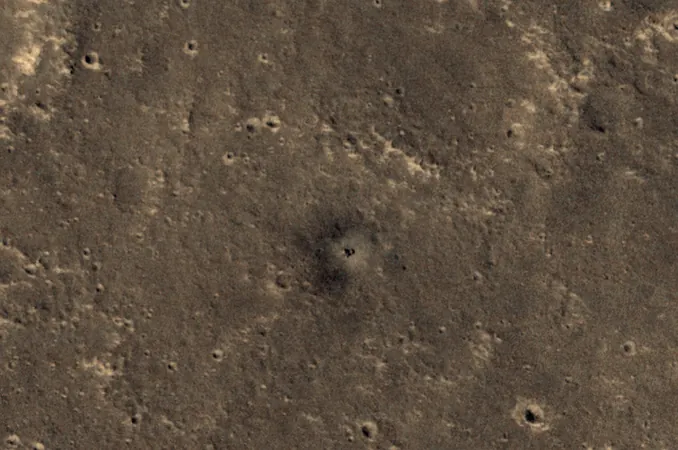
NASA's Iconic InSight Lander: A Silent Sentinel Collecting Dust Data on Mars
2025-01-05
Author: Lok
Overview of InSight's Mission
NASA's Mars Reconnaissance Orbiter (MRO) has recently captured stunning images of the agency's InSight lander, which has been quietly dormant on the Martian surface for the past two years. These new visuals reveal significant movements of Martian dust around InSight, providing planetary scientists with invaluable insights into Mars' climate and atmospheric dynamics.
Mission Objectives and Achievements
InSight, which stands for Interior Exploration using Seismic Investigations, Geodesy, and Heat Transport, successfully touched down in the Elysium Planitia region on November 26, 2018, after a seven-month interplanetary journey. The primary objectives of its mission included measuring seismic activity, enhancing models of Mars' internal heat transfer, and creating detailed mappings of the planet's interior. Over its four-year operational period, InSight contributed groundbreaking data but eventually succumbed to power issues caused by dust accumulation on its solar panels, leading to the conclusion of its mission.
Dust Accumulation and Monitoring
The winds of Mars often contributed to small dust storms that blanketed InSight and its immediate surroundings. Throughout its mission, both InSight's own camera and the MRO's HiRISE camera captured vital imagery to assess the dust levels on the lander's solar panels. While InSight can no longer provide direct readings, MRO is still operational, delivering images that help scientists understand the dust accumulation and movement in InSight's vicinity.
Scientific Impact of Dust Devils
Ingrid Daubar, a researcher from Brown University, articulated the ongoing relevance of InSight, stating, “Even though we’re no longer hearing from InSight, it’s still teaching us about Mars. By monitoring how much dust collects on the surface—and how much gets vacuumed away by wind and dust devils—we learn more about the wind, dust cycle, and other processes that shape the planet.”
Seasonal Variability of Dust Devils
Dust devils, common features of Mars' dust-laden atmosphere, have long been a subject of interest. These swirling whirlwinds not only provide a natural cleaning mechanism for landers and rovers but also allow scientists to deepen their understanding of Martian atmospheric behavior. MRO's latest findings have shown numerous dust devil tracks near InSight, illustrating their seasonal variability, peaking in the Martian summer while dwindling in winter.
Insights from Impact Craters
Moreover, MRO's continuous monitoring has enabled insights into the impact of meteoroids on Mars. In contrast to Earth, where shifting tectonic plates continuously recycle the surface and erase impact craters, martian craters remain markers of its geological history. Interestingly, dust can obscure or “disappear” craters, helping researchers ascertain the age of impacts based on the rate of dust accumulation.
Research on InSight’s Landing Craters
The small craters created by InSight's landing thrusters offer another avenue for research into how dust interacts with the Martian surface. Initially dark brown against the landscape, these craters have blended into the surrounding red-brown terrain as dust has gradually filled them.
The Legacy of InSight
Reflecting on the mission, Daubar poignantly remarked, “It feels a little bittersweet to look at InSight now. It was a successful mission that produced lots of great science... of course, it would have been nice if it kept going forever, but we knew that wouldn’t happen.”
End of an Era
As engineers continued to monitor radio signals from InSight, hoping for a potential resurrection if a dust devil were to clear its solar panels, there have been no new communications in two years. NASA has announced plans to cease attempts to contact the lander by the end of 2024, marking a poignant farewell. The last images captured by the MRO HiRISE camera will serve as a lasting tribute to InSight, which will remain a significant monument to Martian geology and exploration for many years to come.
Conclusion
These recent developments underscore not only the impressive capabilities of robotic missions on Mars but also serve as a reminder of the ongoing journey of exploration in understanding our neighboring planet's enigmatic environment. The legacy of InSight will undoubtedly pave the way for future endeavors aimed at unraveling the mysteries of the Red Planet.

 Brasil (PT)
Brasil (PT)
 Canada (EN)
Canada (EN)
 Chile (ES)
Chile (ES)
 Česko (CS)
Česko (CS)
 대한민국 (KO)
대한민국 (KO)
 España (ES)
España (ES)
 France (FR)
France (FR)
 Hong Kong (EN)
Hong Kong (EN)
 Italia (IT)
Italia (IT)
 日本 (JA)
日本 (JA)
 Magyarország (HU)
Magyarország (HU)
 Norge (NO)
Norge (NO)
 Polska (PL)
Polska (PL)
 Schweiz (DE)
Schweiz (DE)
 Singapore (EN)
Singapore (EN)
 Sverige (SV)
Sverige (SV)
 Suomi (FI)
Suomi (FI)
 Türkiye (TR)
Türkiye (TR)
 الإمارات العربية المتحدة (AR)
الإمارات العربية المتحدة (AR)